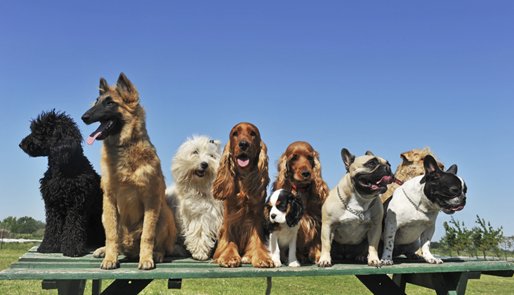Different Breeds of Dogs – Considering a New Pet
By Sally Gutteridge | Breeds

 Are you thinking of introducing a new dog into your home but confused about what type of dog would suit your family and lifestyle? Perhaps you can’t decide whether to give a home to an adult dog or puppy and need a little more information or advice before making a decision?
Are you thinking of introducing a new dog into your home but confused about what type of dog would suit your family and lifestyle? Perhaps you can’t decide whether to give a home to an adult dog or puppy and need a little more information or advice before making a decision?
Read on to learn some interesting facts about common dog breeds and the traits that they can bring into a family home. Every dog will either be a pure breed, or if a cross breed, its looks and behavior will show what type of dog it is genetically related to. When you choose a dog it is certainly important to try and match its needs to your own needs as an owner. By taking the fundamental needs of breeds of dogs into consideration you are most likely to succeed in your choice of new dog. Here are some useful tips to consider when finding a dog to take home.
Breed type
Research the breed type of any dog that you are interested in. Learn from the internet and other dog owners any problems that they have needed to deal with when living with a dog of this particular breed. Find people that already live with a dog of this breed and ask if they have any common problems.
Carrying out some research will ensure that you are expecting the breed traits that your new dog may show in your home. You can also recognize common health problems if you know what to look for when choosing your dog. An example of this could be the gait of a German shepherd dog which to the informed eye can show quite obvious signs of severe hip problems.
Exercise needs
Find out the exercise needs of the dog that you would like to take home and match them to your own exercise routines. It is worth researching how much mental stimulation a dog needs too as all dogs are different but animals of the same breed can show striking similarities.
Some dogs are built to run for miles and enjoy long challenging walks. Other breeds of dog are happy with shorter walks and lots of relaxation time. When choosing a dog it is important that you are honest with yourself about how much exercise that you can realistically offer. A dog that needs a lot of exercise can develop problems within the home if its basic exercise needs are not met. Mental needs of pet dogs also vary greatly, some will become bored quickly and demand attention and others are happy to relax for most of the day. Decide how much time you have to offer for dog training needs and match these to the needs of the dog you choose. This careful planning will be worth it long term.
The working dog
Dogs originally bred to work will have traits and needs, sometimes diluted, that will need to be met to ensure happiness in the home. If you like a dog that was originally or still is a working breed then you can get an idea of how it will behave by looking into its role when employed. Look into the breed and find out whether it is still bred to work now or predominantly a pet. Some dogs have working type and show type; this includes the cocker spaniel and Labrador. Both of the aforementioned can offer very different types of same breed dogs.
Careful consideration of breed type with view to the dog performing a function will give you an idea of how much mental and physical stimulation that the dog may need in order to stay happy and fulfilled. An example of this is the Border collie who is a popular pet and can behave perfectly in the home when its needs are met. The collie however is bred for rounding up and herding sheep therefore has a lot of energy so will need a lot of exercise and mental stimulation to be happy in a family home.
Choose your new dog with care and careful consideration, the little extra time spent on research will help you to understand both whether a dog is suited to you and why he behaves like he does. If you would like access to a great community of dog lovers to share your questions please visit our friendly and information packed dog forum.
Session expired
Please log in again. The login page will open in a new tab. After logging in you can close it and return to this page.